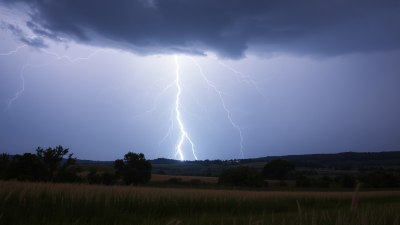How Wind Direction Reveals What's Coming Next
Discover how understanding wind direction can help predict weather changes and what's coming next with expert insights.

Wind direction is a critical factor in weather prediction, offering valuable clues about upcoming weather patterns and changes. By observing the direction from which the wind blows, meteorologists and even casual observers can anticipate shifts in temperature, humidity, and precipitation. This article explores how wind direction functions as a natural indicator, what it reveals about weather, and how you can use this knowledge in daily life.
Understanding Wind Direction
Wind direction is the direction from which the wind originates. It is usually reported using the cardinal points: north, south, east, west, and their intermediates like northeast or southwest. For example, a north wind blows from the north toward the south.
The importance of wind direction lies in its ability to bring different air masses with distinct temperature and moisture characteristics. When the wind changes direction, it often signals the arrival of a new weather system or the transition between different weather phases.
The Science Behind Wind and Weather Patterns
Wind is caused by the uneven heating of the Earth's surface by the sun. As warm air rises, cooler air moves in to replace it, causing wind. The Earth's rotation and topography also influence wind patterns. Large-scale wind currents distribute heat and moisture across the globe, affecting local and regional weather.
Air masses, large volumes of air with uniform temperature and humidity, move along with prevailing winds. When a wind direction shifts, it may mean a new air mass is arriving—for example, colder, drier air from the north or warmer, moist air from the south.
Recognizing Weather Changes Through Wind Direction
Different wind directions are associated with typical weather conditions depending on the location. For instance, in many temperate zones, a wind from the north often brings cooler air, signaling a drop in temperature. Conversely, winds from the south might bring warmer temperatures and increased humidity.
Coastal regions experience distinctive changes as well. Sea breezes, which blow from the ocean during the day, bring cooler air inland, while land breezes blow at night, bringing cooler air from land out to sea.
Wind Direction and Storm Prediction
Storms and fronts often alter wind directions dramatically. A sudden shift in wind can indicate the approach of a front, a boundary between two air masses. For example, if winds suddenly veer from southeast to southwest, this might suggest a warm front is passing, typically resulting in increased clouds and precipitation.
Conversely, a wind direction shift to the west or northwest often signals the arrival of a cold front, which may bring storms, gusty winds, and abrupt temperature drops. Tracking these changes lets meteorologists provide timely warnings about severe weather.
How Local Geography Influences Wind Patterns
Terrain features such as mountains, valleys, and bodies of water can significantly influence wind direction and strength. Mountains can block or channel winds, causing them to shift direction or speed up as they funnel through narrow passes.
Valleys often experience diurnal wind shifts due to temperature differences between the valley floor and surrounding slopes. These localized wind patterns add complexity to weather prediction based solely on general wind direction, highlighting the need to understand local geography.
Tools for Measuring Wind Direction
The primary instrument for measuring wind direction is the wind vane, a device that rotates freely and points in the direction the wind originates. Modern weather stations use electronic anemometers with directional sensors to provide precise real-time data.
Weather forecasts rely on networks of these instruments to track changing wind patterns across regions, helping identify developing weather systems and improving the accuracy of prediction models.
Applying Wind Direction Knowledge Practically
Understanding wind direction is useful beyond weather prediction. Sailors use wind direction to navigate and optimize speed. Pilots account for wind when planning takeoffs and landings. Farmers monitor wind to manage spray applications and reduce drift of chemicals.
Even outdoor enthusiasts benefit from knowing prevailing wind patterns, choosing appropriate clothing, timing for activities, and identifying potential weather hazards before they occur.
Historical Use of Wind Direction in Weather Forecasting
Before modern meteorology, people relied heavily on wind direction to predict weather. Ancient mariners observed wind to foresee storms or safe passage. Farmers anticipated rain or cold snaps by noting changes in wind direction.
These empirical observations laid the groundwork for modern meteorology, where wind data is combined with satellite imagery, radar, and computer modeling to create comprehensive forecasts.
Examples of Wind Direction Indicators in Different Climates
In the Mediterranean, wind from the south often brings hot, dry weather due to desert air masses. In contrast, northerly winds can bring cooler, moist air causing rain. In tropical climates, trade winds consistently blow from east to west, influencing hurricane paths and rainfall patterns.
In northern Europe, east winds often signal cold continental air, whereas west winds bring milder, moist air from the Atlantic. Recognizing these patterns helps locals prepare for expected weather.
Wind Direction and Climate Considerations
While wind direction is a powerful tool in short-term weather prediction, it also plays a role in understanding climates. Prevailing wind patterns determine long-term weather characteristics of regions by controlling moisture delivery and temperature moderation.
For example, the monsoon winds in South Asia shift seasonally, bringing distinct wet and dry periods essential to agriculture and ecosystem health. Thus, wind direction not only predicts daily weather but also shapes climate.
Challenges and Limitations
While informative, wind direction alone does not provide a complete picture. Other factors such as pressure systems, humidity, temperature, and geographic effects must be considered. Wind direction can be variable, especially in complex terrain, causing unpredictable weather conditions.
Furthermore, short-term gusts may mislead casual observers. Accurate weather prediction requires comprehensive data and experience interpreting changing patterns.
Advances in Technology Enhancing Wind Analysis
Technological progress has improved wind measurement and forecasting. Doppler radar detects wind speed and direction within storms, aiding severe weather warnings. Satellite remote sensing tracks global wind patterns, assisting in hurricane tracking and climate studies.
Computer models integrate vast amounts of wind data with other meteorological information to generate detailed forecasts. These advancements augment the foundational knowledge of wind direction's impact on weather.
How to Observe Wind Direction at Home
You can observe wind direction without specialized tools using simple methods. Wind vanes can be homemade using a lightweight arrow or pointer mounted to rotate freely. Flags, tree movements, or smoke direction also indicate wind direction.
Putting a lightweight ribbon, grass clump, or lightweight streamer on a stick outdoors can help you see which way the wind blows. Repeated observation over days helps recognize patterns associated with weather changes.
Interpreting Wind Direction with Other Natural Signs
Wind direction, combined with changes in sky color, cloud types, humidity levels, and temperature, gives a fuller weather prediction. For example, a wind shift accompanied by thickening clouds often indicates an approaching storm.
Listening to natural sounds, such as bird movements or insect activity, can offer additional clues about weather shifts tied to changing winds.
Practical Safety Tips Related to Wind Direction
Recognizing wind direction can be critical for safety during severe weather events. If winds shift toward a known storm direction, it's time to seek shelter. Mariners should heed changes in wind to avoid dangerous conditions at sea.
During wildfire seasons, wind direction impacts fire spread, and evacuation routes may be chosen accordingly. Understanding these practical implications helps in emergency preparedness.
Ultimately, wind direction is a powerful natural indicator, bridging centuries of human observation with modern scientific understanding to reveal what lies ahead in the ever-changing sky.











